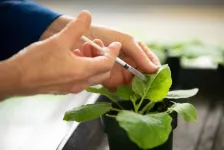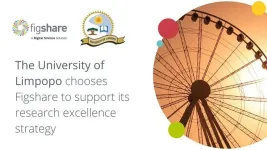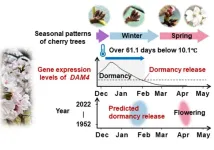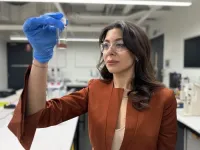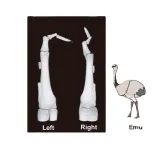(Press-News.org) Scientists have learned how plants keep viruses from being passed to their offspring, a finding that could ensure healthier crops. The discovery could also help reduce the transmission of diseases from mothers to human children.
Plant viruses are often able to spread from one country to another through the seed trade. As a result, parent-to-progeny disease transmission is of global concern.
“Viruses can hide in seeds for years, making this one of the most important issues in agriculture,” said UC Riverside distinguished professor Shou-Wei Ding in the Department of Microbiology and Plant Pathology. Ding is corresponding author of a new paper about the discovery in the journal Cell Host & Microbe.
When a mother plant with a virus makes, for example, 100 seeds, only between 0 and 5% of the seedlings are likely to become infected. For a century, scientists have wondered how the mothers are able to stop the virus from spreading to all or most of the young plants.
The UCR-led team wanted to solve this mystery by pinpointing the immune pathway that prevents virus transmission from parent to progeny, also called vertical transmission. The team succeeded. The strategy they used, and the pathway they identified, are detailed in the new paper.
Hundreds of varieties of Arabidopsis, a small plant in the mustard family, were inoculated with cucumber mosaic virus. Despite its name, the virus can infect more than 1,000 plant species, and cause yellowing, ring-shaped spots, and the appearance of patterns on leaf and fruit surfaces. Then, the researchers analyzed the plants to learn which genes make them, and their progeny, more resistant to the virus.
Two genes, both of which are only known to be functional during the early stages of seed development, appear to be most important for this purpose. These genes operate in what’s called the RNA interference pathway.
Genetic information in cells is converted from DNA into RNA, and then into proteins. Sometimes, double-stranded RNA is cut into smaller fragments called small interfering RNA, or siRNA. These fragments are used to block the production of proteins, some of which may come from an invading virus.
“Many organisms produce siRNAs to control and inhibit viral infections,” Ding explained. “We believe the reason these plants can prevent seed infections is because the antiviral RNA interference pathway is active when seeds are being developed within mother plants.”
To examine their hypothesis, the researchers made mutant plants in which two key RNA interference pathway genes were deleted. These genes create enzymes called dicer-like 2 and dicer-like 4.
“Without these two enzymes, the plant cannot make siRNAs to inhibit viral infections. And without the siRNAs, the antiviral immune pathways are not functional,” Ding said.
The mutant plants both grew and produced seeds normally. However, when the plants lacking these two enzymes were infected with cucumber mosaic virus, they developed very severe symptoms. They made fewer seeds, and more importantly, there was a tenfold increase in the rate of transmission to the seeds. Up to 40% of the new seedlings were infected.
“We got really excited by this result,” Ding said. “This is the first time anybody has seen this major change in seed transmission after an immune pathway is eliminated.”
The next question the researchers set out to answer was how, despite the strong immune suppression in non-mutant plants, can viruses still infect a small percentage of seeds? They learned that it’s because the virus expresses a protein to block the RNA interference pathway in mother plants.
Moving forward, the research team is testing whether they can further decrease virus transmission rates by strengthening the immune pathway they identified in the seeds.
Because this pathway is widely conserved across a variety of organisms, including invertebrates, fungi, and mammals, the discovery could have broad implications for animal as well as human disease prevention.
The researchers have certain human viruses, like Zika, in mind as they continue their work. Zika infection during pregnancy can cause serious birth defects, including microcephaly and other brain abnormalities. The researchers hope to use what they learn to reduce the rate of vertical Zika transmission.
“We know that Zika virus expresses several proteins that block the RNA interference pathway, so it may be possible to prevent vertical transmission by inhibiting the function of these proteins with new drugs.”
END
Stopping plants from passing viruses to their progeny
Discovery could reduce disease transmission to human kids
2024-09-19
ELSE PRESS RELEASES FROM THIS DATE:
NIH awards $2.8M to Rice, Baylor College of Medicine for research on acute respiratory distress syndrome
2024-09-19
HOUSTON – (Sept. 19, 2024) – Rice University and Baylor College of Medicine have received $2.8 million in funding from the National Heart, Lung, and Blood Institute (NHLBI), a division of the National Institutes of Health (NIH), for research on reducing inflammation and lung damage in acute respiratory distress syndrome (ARDS) patients.
The study, titled “Cell Based Immunomodulation to Suppress Lung Inflammation and Promote Repair,” will be co-led by Omid Veiseh, a professor of bioengineering and faculty director of the Rice Biotech Launch Pad, and Ravi Kiran Ghanta, a professor of surgery at Baylor. ...
The University of Limpopo chooses Figshare to support its research excellence strategy
2024-09-19
Figshare, a leading provider of institutional repository infrastructure that supports open research, is pleased to announce that the University of Limpopo has chosen Figshare to facilitate the collection, management, sharing and preservation of its research data.
The University of Limpopo – one of the top public universities in South Africa offering undergraduate and postgraduate qualifications, and a variety of short learning programmes – will become the 20th institution in the country using Figshare as their data repository.
Using ...
A new forecasting model based on gene activity predicts when Japan’s cherry buds awake from dormancy
2024-09-19
Fukuoka, Japan – Japan in spring is famous for its cherry blossoms, or sakura, which begin flowering in the southern region of Kyushu and blaze upwards to the remote north of Hokkaido. The most abundant cherry tree cultivar, Somei Yoshino, is the iconic symbol of spring, as the cloned trees flower simultaneously at each site, creating a fleeting explosion of white-pink blossom that enraptures locals and tourists alike. The flowering forecasts of Somei Yoshino are poured over for months before flowering, as visitors plan their trips and locals ...
New organic thermoelectric device that can harvest energy at room temperature
2024-09-19
Fukuoka, Japan—Researchers have developed a new organic thermoelectric device that can harvest energy from ambient temperature. While thermoelectric devices have several uses today, hurdles still exist to their full utilization. By combining the unique abilities of organic materials, the team succeeded in developing a framework for thermoelectric power generation at room temperature without any temperature gradient. Their findings were published in the journal Nature Communications.
Thermoelectric devices, or thermoelectric ...
Activity in brain system that controls eye movements highlights importance of spatial thinking
2024-09-19
The superior colliculus is a midbrain region that is traditionally thought to help animals orient themselves toward important locations in space, like directing their eyes and head toward a bright flash of light. New research from the University of Chicago shows that this part of the brain also plays a role in complex cognitive tasks like visual categorization and decision making.
In the new study, published in Nature Neuroscience, scientists measured the information contained in patterns of brain cell activity across multiple brain regions involved in visual category decisions. The researchers monitored activity in the superior colliculus (SC) and part of the posterior parietal ...
New research reenvisions Earth’s mantle as a relatively uniform reservoir
2024-09-19
Lavas from hotspots—whether erupting in Hawaii, Samoa or Iceland—likely originate from a worldwide, uniform reservoir in Earth’s mantle, according to an evaluation of volcanic hotspots published today in Nature Geoscience.
The findings indicate Earth’s mantle is far more chemically homogenous than scientists previously thought—and that lavas only acquire their unique chemical “flavours” enroute to the surface.
“The discovery literally turns our view of hotspot lavas and the mantle upside down,” said Dr. Matthijs Smit, associate professor ...
Global warming leads to drier and hotter Amazon: reducing uncertainty in future rainforest carbon loss
2024-09-19
The Amazon, often called the "lungs of the planet", is the world’s largest tropical forest, playing a crucial role in the global climate system due to its vast carbon storage. While it is typically warm and humid all year round, continued climate change poses the threat of more frequent and severe droughts and heat extremes. A new study, published in Nature Communications delves into future projections of the Amazon carbon cycle, focusing specifically on the impacts driven by climate change.
Scientists use the latest generation of Earth system models from the Coupled Model Intercomparison Project which contributed to ...
Low-carbon ammonia offers green alternative for agriculture and hydrogen transport
2024-09-19
A new way of making ammonia by harnessing the unique power of liquid metal could lead to significant cuts in carbon emissions caused by production of the widely-used chemical.
Ammonia is used in fertiliser to grow much of our food, but also plays a role in clean energy as a carrier to safely transport hydrogen.
The global production of ammonia, however, comes at a high environmental cost: it consumes over 2% of global energy and produces up to 2% of global carbon emissions.
RMIT Research Fellow and study ...
New mechanism uncovered for the reduction of emu wings
2024-09-19
Researchers have uncovered a fascinating mechanism behind the reduction and asymmetry of emu wing bones. The wings not only show significant shortening, but the skeletal elements also fuse asymmetrically, a phenomenon traced back to the absence of muscle formation in the distal regions of the wings. During development, this lack of muscle leads to insufficient mechanical stress, which is crucial for proper bone formation. The team identified muscle progenitor cells with a unique dual identity, combining characteristics of both somite1-derived myogenic and lateral plate mesoderm2 cells. These ...
Zeroing in on the genes that snakes use to produce venom
2024-09-19
Only about ten percent of the world’s roughly 4,000 snake species have venom strong enough to seriously hurt a human, but that’s enough for snake bites to be an important public health concern. To help better understand how snakes make their venom and how venoms differ from one species to another, researchers developed a new way to zero in on the genes that snakes use in venom production. Their work was published in the journal Molecular Ecology Resources.
“We’ve developed a tool that can tell us which venom-producing genes are present across an entire snake family in one fell swoop,” says Sara Ruane, the Assistant Curator of Herpetology in the ...
LAST 30 PRESS RELEASES:
Study: Teens use cellphones for an hour a day at school
After more than two years of war, Palestinian children are hungry, denied education and “like the living dead”
The untold story of life with Prader-Willi syndrome - according to the siblings who live it
How the parasite that ‘gave up sex’ found more hosts – and why its victory won’t last
When is it time to jump? The boiling frog problem of AI use in physics education
Twitter data reveals partisan divide in understanding why pollen season's getting worse
AI is quick but risky for updating old software
Revolutionizing biosecurity: new multi-omics framework to transform invasive species management
From ancient herb to modern medicine: new review unveils the multi-targeted healing potential of Borago officinalis
Building a global scientific community: Biological Diversity Journal announces dual recruitment of Editorial Board and Youth Editorial Board members
Microbes that break down antibiotics help protect ecosystems under drug pollution
Smart biochar that remembers pollutants offers a new way to clean water and recycle biomass
Rice genes matter more than domestication in shaping plant microbiomes
Ticking time bomb: Some farmers report as many as 70 tick encounters over a 6-month period
Turning garden and crop waste into plastics
Scientists discover ‘platypus galaxies’ in the early universe
Seeing thyroid cancer in a new light: when AI meets label-free imaging in the operating room
Neutrophil-to-lymphocyte ratio may aid risk stratification in depressive disorder
2026 Seismological Society of America Annual Meeting
AI-powered ECG analysis offers promising path for early detection of chronic obstructive pulmonary disease, says Mount Sinai researchers
GIMM uncovers flaws in lab-grown heart cells and paves the way for improved treatments
Cracking the evolutionary code of sleep
Medications could help the aging brain cope with surgery, memory impairment
Back pain linked to worse sleep years later in men over 65, according to study
CDC urges ‘shared decision-making’ on some childhood vaccines; many unclear about what that means
New research finds that an ‘equal treatment’ approach to economic opportunity advertising can backfire
Researchers create shape-shifting, self-navigating microparticles
Science army mobilizes to map US soil microbiome
Researchers develop new tools to turn grain crops into biosensors
Do supervised consumption sites bring increased crime? Study suggests that’s a myth
[Press-News.org] Stopping plants from passing viruses to their progenyDiscovery could reduce disease transmission to human kids
